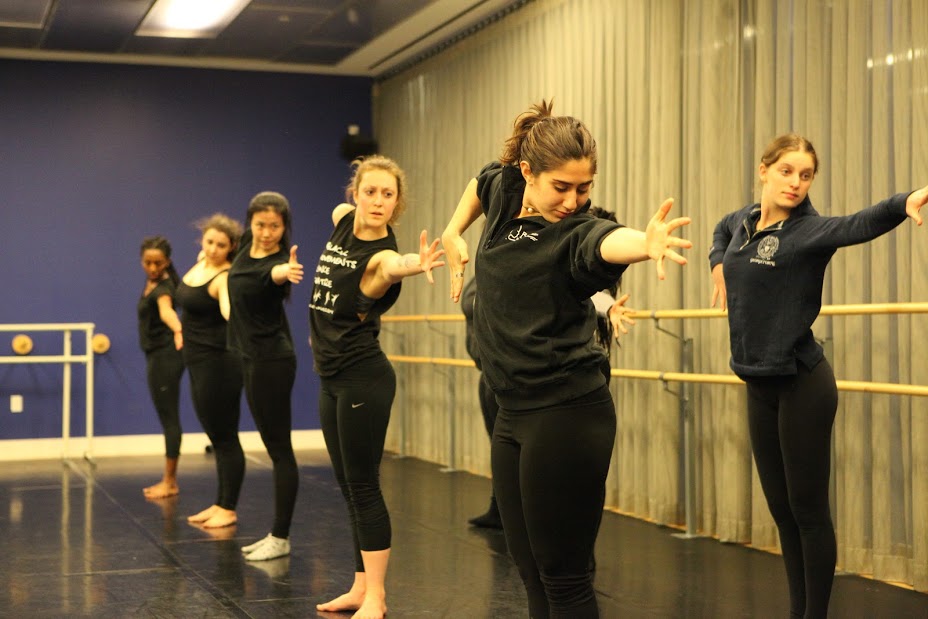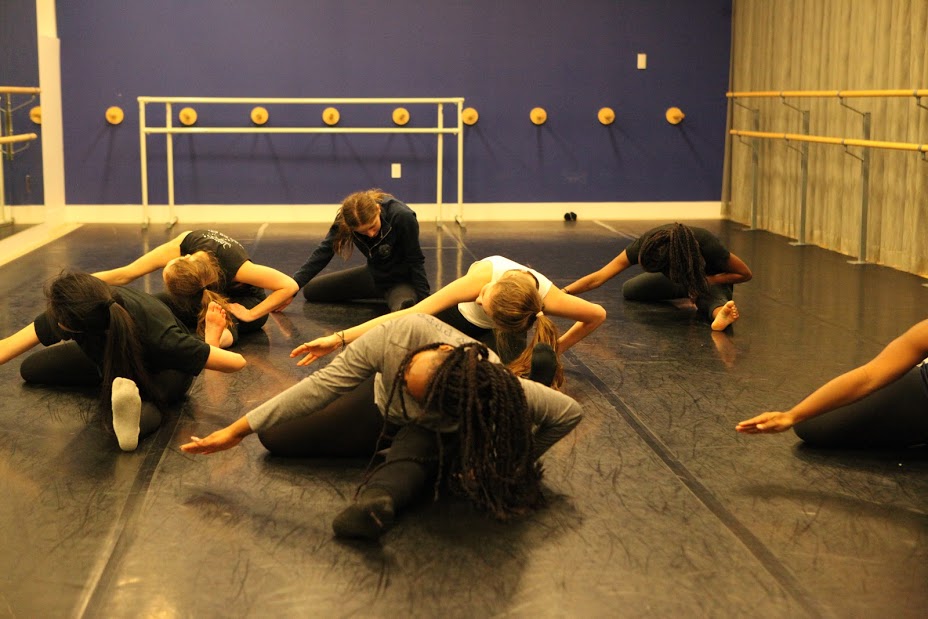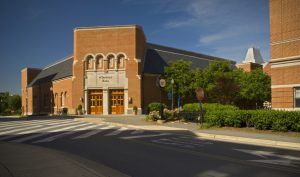Bodies tumble to the ground. Dancers fall, then carry each other around the studio. Pained, passionate faces match the sharp movements as Erykah Badu’s voice repeats the words, “This bitter land” from her song with the same name. For Black Movements Dance Theatre (BMDT), it’s all about the message behind the dance.
In preparation for its spring concert, the group is working through a piece choreographed by guest artist Christopher Huggins, who has danced with the Alvin Ailey American Dance Theatre, a prestigious company founded by Ailey, a choreographer and activist who influenced modern dance and paved the way for many black artists in the field.
“It’s an examination of what was and in many ways still is,” said BMDT’s artistic director Alfreda Davis, a professor in the Department of Performing Arts, regarding the inspiration behind the dance that Huggins shared with her.
The dance ends with one member turning to what will soon be the audience in the Gonda Theatre and asking, “So what you gonna do?” –– the last line of the accompanying song that invokes images of police brutality.
Huggins’ piece, among others, will be highlighted during BMDT’s spring concert, Defiance, on Feb. 24-25, when the company celebrates its 35th anniversary. Inspired by the success of black female olympians and fueled by the current political context in the United States, Defiance continues BMDT’s history of dance motivated by social justice and empowerment of all people who face oppression.
“Being a part of the company, it’s not only about coming in, dancing, doing a plié, and leaving. That’s not what it’s about. We’re trying to relay a larger message,” said Ashley Newman (COL ‘18), one of BMDT’s student directors.
Although founded in 1982 to express black experiences through dance, BMDT has never been a company limited only to black dancers or black audiences, said Elizabeth Erra (COL ‘17), a student director of BMDT. Embracing diversity within the Georgetown community is also one of its founding tenets. Though no longer a majority-black group, many dancers see the diversity in the company as one of its strongest assets to spread broader messages about racial justice.

Kevin Choi
“Everyone is really open and interested and invested in learning more about one another, which is why I think BMDT is so great because it provides that space for people to have those difficult conversations and then bring that difficulty through movement, so a lot of what we talk about we try to convey with dance,” said Erra.
Erra noted that the diversity of the group today continues the long tradition of the need for diversity in dance. She explained that while the dance world remains segregated today due to costly dance training, BMDT embraces dancers of all skill levels.
Ariel Calver (COL ‘20), who has been dancing since she was four years old, joined BMDT last semester to expose herself to new dance styles and noted that diversity in BMDT goes beyond race.
“We have people of completely different body shapes — really tall, really short. And no matter what, when you watch everyone dancing, they look amazing when they’re doing it,” Calver said. “No matter who you are, you can dance.”
Whether it’s jazz, hip hop, traditional African dance, or almost any other style, BMDT employs a variety of genres to tell complex story lines, and Defiance is no exception.
Joy Wang (COL ‘19), who grew up in Beijing, choreographed a dance for the concert that combines Chinese traditional dance with contemporary dance to convey a message that emphasizes the need for educational access for women.
The dancers move with a sharp precision, their arms open and pointed as Wang’s dance begins. Davis called it a perfect example of keeping with the founding mission of BMDT while still embracing the company’s diversity.
For Wang, stories of young girls in rural China and around the world who work to advocate for women’s right to education epitomize Defiance.
Choreographing a traditional Chinese dance for BMDT did come with some challenges, though, mostly related to the technical side of dance, Wang said.
“People move differently, so they can’t really understand what a gesture is trying to convey. It really takes me a lot of time to figure out what kind of gesture can show the audience directly what I want to convey,” Wang added.
Jasmin Joseph (MSB ‘17), who faced similar obstacles when choreographing a South African dance last semester, noted how challenging it can be to connect to other students’ choreography, like Wang’s dance, both because of the technical aspects of dance and because of the group’s diverse backgrounds.
In Defiance, dances address abstract concepts of overcoming adversity and historical events, such as the Freedom Riders movement. For BMDT, its identity as a dance theatre — not just a dance group — matters to students as they begin to think about the story behind each dance. For example, Davis explained that when guest artist Levi Marsman worked with the group, he told them about being in Dallas during the July 2016 police shooting — the central narrative of his dance — before even showing them a single movement in the piece.
In order to get dancers to think about the characters they portray on stage, Davis also had her students submit written responses to questions about how they specifically connect to each dance in which they perform.
Joseph said that, in the past year, finding emotional inspiration as a dancer has not been hard given the current racial climate in the United States. As BMDT’s members continue to navigate their own identities, the group has also seen increased messaging around social justice in their performances. “We’re dancing for a reason here,” Joseph said.
As a freshman, Erra had a harder time connecting with dances, but as the group has made a more explicit effort to address social issues, it has become easier for her. After the Women’s March on Washington in January, the company sat down and talked before dancing. Whether or not they supported the march, all the dancers were able to express their feelings during a challenging, emotional time. These conversations manifest themselves at BMDT’s concerts with videos and music that directly address current events and injustices. In December 2016, the group held a question and answer session after the show to allow audience members and the company to engage with the context around the pieces.
“BMDT is a group of people who aren’t afraid to express and talk about a lot of taboo subjects,” Newman said. In a dance she choreographed for Defiance, she portrayed her struggles of growing up as a young black girl in a predominately white school district. Trying to keep to her white classmates’ beauty standards, Newman said it wasn’t until she came to Georgetown that she came to terms with her own beauty as a black woman. To convey this message, she separated the white dancers in her piece from the dancers of color, each group wearing different costumes.
“There’s beauty in the diversity that is your skin and that is my skin,” Newman said. “That difference between us is what makes everyone unique.”
“Dancers are thinkers,” Davis said, a line that she often repeats to her students. Citing singer and activist Paul Robeson, Davis described artists as gatekeepers for a radical voice and said they are always a pulse for what happens in society. Davis sees BMDT as fitting into Georgetown’s larger mission of engagement with social justice issues.
This year, the company received funding from a variety of sources on campus, including the Office of the President and the Corp, which has allowed it to bring in dancers like Huggins and Marsman, Davis said. She also praised the university for embracing and reconciling with its history of slavery. A grant from the Working Group on Slavery, Memory, and Reconciliation will help fund in part a short documentary to be showed at Defiance about the founding of BMDT.
As the company prepares for its 35th anniversary show, Erra said the presence of BMDT on campus remains a necessity.
“We use creative ways to talk about issues that occur on campus and nationally. It’s different stumbling upon a protest in Red Square than it is to come to a show,” Erra said. “And I think there are still some challenges within systems and institutions at Georgetown that require that we have a presence on campus, that we still have access to certain resources so that we’re able to do what we’ve done for the past almost four decades.”





